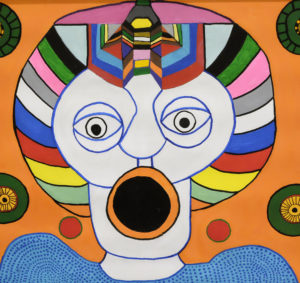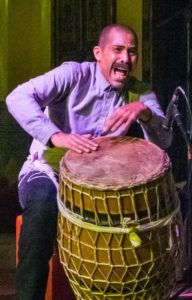Roscoe Mitchell — internationally renown composer, improviser, ensemble leader, winds and reeds virtuoso who has pioneered the use of “little instruments” and dramatic shifts of sonic scale in the course of becoming a “supermusician . . .someone who moves freely in music, but, of course, with a well established background behind . . .”* reveals […]
Legacies of Music Makers
The deaths of multi-instrumentalist Joseph Jarman, best known as the face-painted shaman of the Art Ensemble of Chicago, and Alvin Fielder, re-conceptualizing drummer, remind us that artists’ contributions to music extend beyond recordings and awards. Read my essay at NPR Music, commissioned by Nate Chinen of WBGO, on the enduring legacies of Jarman and Fielder, […]
Jazz warms Chi spots: Hot House @ Alhambra Palace, AACM @ Promontory
There are good arguments for building venues just for jazz. But speaking of arts communities in general: Most are moveable feasts, fluid, transient, at best inviting to newcomers to the table. It’s demonstrable that when jazz players and listeners alight at all-purpose spaces such as Chicago’s Alhambra Palace, where Hot House produced the trio of saxophonist David Murray, bassist […]
Announcing eyeJAZZ.tv & Happy 45th b’day AACM
eyeJAZZ.tv, a wave of guerrilla video music-news clips being initiated by the Jazz Journalists Association, has posted its first example — my brief production from last week’s 45th birthday concert of the AACM featuring composer-saxophonist Roscoe Mitchell, flutist and AACM chair Nicole Mitchell (no relation) and saxophonist Ari Brown, at Chicago’s Museum of Contemporary Art.
AACM at 45: “Creative Musicians” span generations, U.S., globe
The AACM — Association for the Advancement of Creative Musicians — continues after 45 years to encourage highly original, edgy and exciting artists — as I detail in my new City Arts column. Examples in New York City: reedist/composer Henry Threadgill’s Zooid performs tonight and tomorrow at Roulette; trumpeter Wadada Leo Smith’s 22-piece Silver Orchestra and the […]
Fred Anderson, Chicago jazz hero, appreciated
As a teenager in pursuit of the avant garde, I took tenor saxophonist Fred Anderson, who died June 24 at age 81, as a hero upon first hearing him in 1966. It was at a Unitarian Church-run coffee house in downtown Evanston near Northwestern U., and attention clearly had to be paid to the long, fierce, unreeling, knotty […]
AACM pianist & singer give away CD at NYC show
Steve Colson, pianist/composer and band leader, with vocalist Iqua Colson — a couple members of American experimental music‘s cutting edge AACM for some 35 years — give a rare performance quartet Saturday night (Feb 6) at NYC’s Thalia theater in Symphony Space. Everyone who attends gets the Colsons’ new CD, The Untarnished Dream, for free. One-time promotion? Start of […]
Chicago’s quirky hero of blues and jazz in NYT
Bob Koester, owner-operator of Delmark Records and the Jazz Record Mart, is celebrated in the New York Times’ Arts & Leisure section today. He’s documented and marketed South and West Side soul, AACM innovation, trad jazz and the Mississippi Delta blues revival. I’m among the many music fans who grew up in his sway — and include […]
Happy Birthday, Fred Anderson
Fred Anderson, tenor saxophonist, is one of America’s less-acknowledged Jazz Masters, a man of deep musicality who has had enormous influence on three generations of players and listeners drawn by his brawny, free-wheeling Chicago sound. He turns 80 on March 22, and a weeklong celebration at the Velvet Lounge, his music room on the near-South […]



